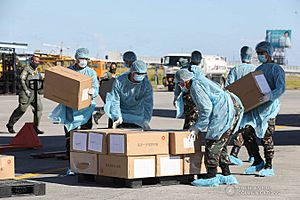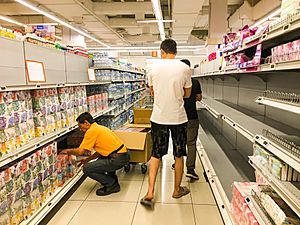COVID-19 pandemic facts for kids
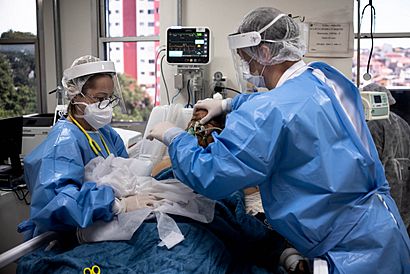
|
|||||||
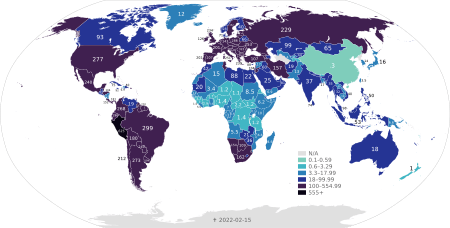
as of 18 January 2023 |
|||||||
|
|||||||
| Disease | Coronavirus disease 2019 (COVID-19) | ||||||
|---|---|---|---|---|---|---|---|
| Virus strain | Severe acute respiratory syndrome coronavirus 2 (SARS‑CoV‑2) |
||||||
| Location | Worldwide | ||||||
| Date | First case of COVID-19: November 17, 2019
Public health emergency of international concern: January 30, 2020 – May 5, 2023 (3 years, 3 months and 5 days) |
||||||
| Confirmed cases | 775,379,850 | ||||||
|
Deaths
|
7,047,396 (reported) 16.6–28.3 million (estimated) |
||||||
The COVID-19 pandemic was a worldwide outbreak of a new illness called COVID-19. It started in Wuhan, China, in December 2019. The illness quickly spread across Asia and then to almost every country in the world by early 2020.
People with COVID-19 could have no symptoms at all, or they could get very sick. Common symptoms included fever, a sore throat, a cough, and feeling very tired. The virus mainly spread through tiny particles in the air when an infected person coughed, sneezed, or even talked.
Scientists quickly developed COVID-19 vaccines. These vaccines started being given to people in December 2020. To slow the spread, many places had travel limits, lockdowns, and rules about wearing face masks. People also used tests and contact tracing to find and isolate sick people.
The pandemic caused big changes around the world. It affected how people lived, worked, and learned. It also led to a major global economic downturn. It is considered one of the deadliest pandemics ever.
Contents
What Caused COVID-19?

The virus that causes COVID-19 is called SARS-CoV-2. It belongs to a large group of viruses known as coronaviruses. Coronaviruses can infect humans and many animals, like livestock and pets.
Some human coronaviruses cause mild illnesses, such as the common cold. Others can cause more serious diseases, like Middle East respiratory syndrome (MERS). SARS-CoV-2 was the seventh coronavirus discovered to infect people.
History of the Pandemic
How the Outbreak Began
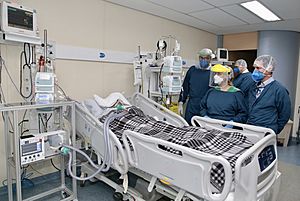
In December 2019, doctors in Wuhan, China, noticed many people getting sick with a new type of pneumonia (a serious lung infection). Doctors realized this was a big problem and started looking for answers. They shared information with scientists worldwide.
Scientists soon found the virus causing this new illness. They named it SARS-CoV-2. "SARS" means Severe Acute Respiratory Syndrome, and "CoV" stands for coronavirus. The "2" means it's a new version of a SARS-causing coronavirus.
SARS-CoV-2 spreads easily from person to person. It travels through tiny droplets when an infected person coughs, sneezes, talks, or breathes. These droplets can get into the mouths or noses of people nearby. They can also be breathed into the lungs. The virus might also spread if you touch a surface with these droplets, then touch your face without washing your hands.
The Pandemic Spreads Worldwide
As more people in Wuhan got sick, the situation became very serious. The illness, now called COVID-19, quickly spread beyond Wuhan and across China. Soon, it reached other countries around the world.
By the end of January 2020, the World Health Organization (WHO) declared a Public Health Emergency of International Concern. This meant the world needed to act fast. Governments started using measures like travel limits. They also used quarantines, where people who might be sick had to stay home. These steps help stop diseases from spreading quickly.
In March 2020, the WHO officially called COVID-19 a pandemic. A pandemic means a new disease is spreading rapidly across the entire globe. The virus was affecting all continents.
How COVID-19 Affected People
COVID-19 affected people in different ways. Some had mild symptoms, like a cough or fever, and got better quickly. Others had more serious symptoms, such as trouble breathing. These people often needed hospitalization. Sadly, some became very sick and needed intensive care. Older people and those with other health problems were most at risk.
Millions of people around the world were infected. It was hard to know the exact number because testing wasn't always available. Sadly, many people died from COVID-19. The number of deaths varied by country.
Hospitals sometimes became very busy because so many people needed medical care. Many countries had lockdowns, asking people to stay home as much as possible. Schools and businesses closed. People had to find new ways to work, learn, and connect.
Global Efforts to Fight the Virus
The pandemic led to a huge international effort. Scientists around the world worked hard to develop vaccines and treatments. Doctors and nurses worked tirelessly to care for sick people. Governments and organizations worked together to help those affected.
Vaccines Against COVID-19
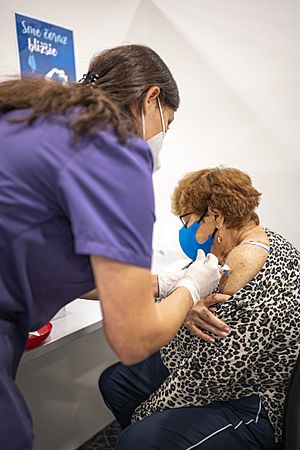
COVID-19 vaccines are widely recognized for helping to reduce how severe the illness was and how many people died from it.
By late 2021, over 4.49 billion people had received at least one vaccine dose. More than 8 billion doses in total were given in over 197 countries. The Oxford-AstraZeneca vaccine was the most used.
In November 2022, new types of vaccines were introduced. This included a booster shot for adults in the United Kingdom and the first inhalable vaccine in Shanghai, China.
Preventing the Spread
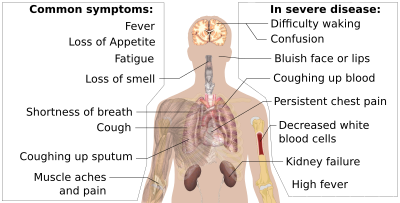
To help prevent infection, people were advised to:
- Get vaccinated.
- Stay home or spend more time outdoors.
- Avoid crowded places.
- Keep a safe distance from others.
- Wear a mask in public.
- Make sure indoor spaces had good air flow.
- Wash hands often with soap and water for at least 20 seconds.
- Cover coughs and sneezes.
- Avoid touching eyes, nose, or mouth with unwashed hands.
Impact of the Pandemic
Economic Changes

The pandemic and the ways countries responded to it hurt the global economy. Travel was greatly reduced due to restrictions and closures of public places. Airlines canceled flights, and some companies, like British regional airline Flybe, went out of business. The cruise industry was also hit hard.
Shops and stores had to reduce their hours or close completely. Many retailers saw a big drop in customers. Shopping centers tried to cope by cleaning more often and checking shoppers' temperatures.
Hundreds of millions of jobs were lost worldwide. The International Labour Organization (ILO) reported that global income from work dropped by 10.7% in the first nine months of 2020. This was a loss of about $3.5 trillion.
Fears about the virus led to panic buying. Stores ran out of things like food, toilet paper, and bottled water. This happened because people felt threatened and worried about shortages.
Supply chains were also disrupted. Factories and ports closed, and there weren't enough workers. This led to shortages of many products.
Impact on Culture and Arts
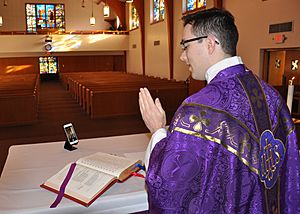
The pandemic greatly affected the performing arts and cultural places. Museums, libraries, and performance venues closed. Exhibitions, events, and shows were canceled or postponed. A UNESCO report estimated that ten million jobs were lost in culture and creative industries worldwide.
Some cultural activities continued online. For example, concerts were live-streamed, and art festivals moved to the internet.
Environmental Effects
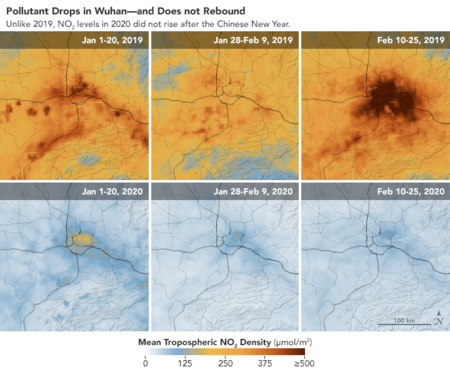
The pandemic and the actions taken against it had some positive effects on the environment. Human activity decreased, leading to less fossil fuel use and less pollution. Air travel and vehicle use dropped. In China, lockdowns led to a 26% drop in coal use and a 50% drop in nitrogen oxide emissions.
Many animals, especially mammals, could get SARS-CoV-2. Some, like farmed and wild mink, got very sick and many died. Other animals, like white-tailed deer, became natural reservoirs for the virus. This means they carried the virus without getting very sick, helping it to spread among their populations.
Changes in Daily Life

The pandemic caused huge changes in how people lived. More people started shopping online. Online sales in the US grew by 32.4% in 2020. Home delivery orders increased, while indoor dining at restaurants stopped.
Unfortunately, hackers and scammers also took advantage of these changes. Education in some countries moved from classrooms to online video calls. Many jobs were lost in the airline, travel, and hospitality industries.
COVID-19 in Pop Culture
The COVID-19 pandemic had a big impact on popular culture. It was included in the stories of TV shows that were already running. It also became the main topic in some new shows and movies. People wondered if it was too soon to make jokes or stories about the pandemic.
Some films and TV series that referenced or were based on the pandemic include:
- South Park: Post Covid: An animated comedy film from 2021 that shows the characters of South Park forty years after the pandemic.
- Songbird: A 2020 science-fiction thriller film. It imagined COVID-19 changing into a more dangerous COVID-23 in 2024.
- Queen Sugar (sixth season): This drama series focused on how the characters dealt with the COVID-19 pandemic. Some characters even caught the virus.
- Social Distance: A 2020 TV series about people coping with the pandemic and quarantine.
Deaths
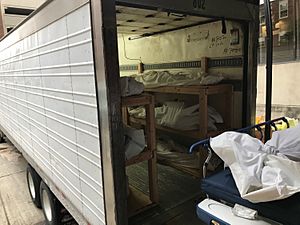

As of 14 May 2024, COVID-19 has caused 7,047,396 confirmed deaths. Experts estimate the total number of deaths could be much higher, between 18.2 and 33.5 million.
Images for kids
See Also
 In Spanish: Pandemia de COVID-19 para niños
In Spanish: Pandemia de COVID-19 para niños



